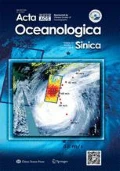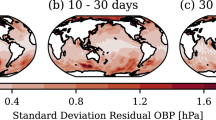Abstract
The impact of assimilating Argo data into an initial field on the short-term forecasting accuracy of temperature and salinity is quantitatively estimated by using a forecasting system of the western North Pacific, on the base of the Princeton ocean model with a generalized coordinate system (POMgcs). This system uses a sequential multigrid three-dimensional variational (3DVAR) analysis scheme to assimilate observation data. Two numerical experiments were conducted with and without Argo temperature and salinity profile data besides conventional temperature and salinity profile data and sea surface height anomaly (SSHa) and sea surface temperature (SST) in the process of assimilating data into the initial fields. The forecast errors are estimated by using independent temperature and salinity profiles during the forecasting period, including the vertical distributions of the horizontally averaged root mean square errors (H-RMSEs) and the horizontal distributions of the vertically averaged mean errors (MEs) and the temporal variation of spatially averaged root mean square errors (S-RMSEs). Comparison between the two experiments shows that the assimilation of Argo data significantly improves the forecast accuracy, with 24% reduction of H-RMSE maximum for the temperature, and the salinity forecasts are improved more obviously, averagely dropping of 50% for H-RMSEs in depth shallower than 300 m. Such improvement is caused by relatively uniform sampling of both temperature and salinity from the Argo drifters in time and space.
Similar content being viewed by others
References
Chu Peter C, Amezaga G R, Gottshall E L, et al. 2007a. Ocean nowcast/forecast systems for improvement of Naval undersea capabilities. Marine Technol Soc J, 41(2): 23–30
Chu Peter C, Fan Chenwu. 2010. A conserved minimal adjustment scheme for stabilization of hydrographic profiles. J Atmos Oceanic Technol, 27(6): 1072–1083
Chu Peter C, Mancini S, Gottshall E L, et al. 2007. Sensitivity of satellite altimetry data assimilation on weapon acoustic preset using MODAS. IEEE J Oceanic Eng, 32: 453–468
Chu Peter C, Wang GuiHua, Fan Chenwu. 2004. Evaluation of the U.S. Navy’smodular ocean data assimilation system (MODAS) using the South China Sea monsoon experiment (SCSMEX) data. J Oceanogr, 60: 1007–1021
Galanis G, Chu Peter C, Kallos G. 2011. Statistical post processes for the improvement of the results of numerical wave prediction models. A combination of Kolmogorov-Zurbenko and Kalman filters. J Operat Oceanogr, 4(1): 23–31
Griffa A, Molcard A, Raicich F, et al. 2006. Assessment of the impact of TS assimilation from ARGO floats in the Mediterranean Sea. Ocean Sci, 2: 237–248
Han Guijun, Li Wei, Zhang Xuefeng, et al. 2011. A regional ocean reanalysis system for China coastal waters and adjacent seas. Advances in Atmospheric Sciences, 28(3): 682–690
He Zhongjie, Han Guijun, Li Wei, et al. 2010. Experiments on assimilating of satellite data in the China seas and adjacent seas (in Chinese). Periodical of Ocean University of China, 40(9): 1–7
Li Wei, Xie Yuanfu, Deng Shiowming, et al. 2010. Application of the multi-grid method to the two-dimensional doppler radar radial velocity data assimilation. J Atmos Oceanic Tech, 27(2): 319–332
Li Wei, Xie Yuanfu, He Zhongjie, et al. 2008. Application of the multigrid data assimilation scheme to the China seas’ temperature forecast. J Atmos Oceanic Technol, 25(11): 2106–2116
Liu Yimin, Zhang Renhe, Yin Yonghong, et al. 2004. The application of ARGO data to the global ocean data assimilation operational system of NCC. Acta Meteorologica Sinica, 19: 355–365
Marshall J, Hill C, Perelman L, et al. 1997. Hydrostatic, quasi-hydrostatic, and nonhydrostatic ocean modelling. J Geophys Res, 102(C3): 5733–5753
Shu Yeqiang, Wang Dongxiao, Zhu Jiang et al. 2011. The 4-D structure of upwelling and Pearl River plume in the northern South China Sea during summer 2008 revealed by a data assimilation model. Ocean Modeling, 36(3–4):228–241
Shu Yeqiang, Zhu Jiang, Wang Dongxiao, et al. 2011. Assimilating remote sensing and in situ observations into a coastal model of northern South China Sea using ensemble Kalman filter. Continental Shelf Research, 31(6): S24–S36
Troccoli A, Balmaseda MA, Segschneider J, et al. 2002. Salinity adjustments in the presence of temperature data assimilation. Mon Wea Rev, 130: 89–102
Wong A P S, Johnson G C, Owens W B. 2003. Delayed-mode calibration of autonomous CTD profiling float salinity data by S-climatology. J Atmos. Oceanic Tech, 20: 308–318
Xiao Xianjun, Wang Dongxiao, Xu Jianjun. 2006. The assimilation experiment in the southwestern South China Sea in summer 2000. Chinese Science Bulletin, 51(2):31–37
Zhu Jiang, Yan Changxiang. 2006. Nonlinear balance constraints in 3DVAR data assimilation. Science in China: D, 49: 331–336
Author information
Authors and Affiliations
Corresponding author
Additional information
Foundation item: The National Natural Science Foundation of China under contract Nos 41030854, 41106005, 41176003, and 41206178; the National Science and Technology Support Programof China under contract No. 2011BAC03B02-01-04.
Rights and permissions
About this article
Cite this article
Fu, H., Chu, P.C., Han, G. et al. Improvement of short-term forecasting in the northwest Pacific through assimilating Argo data into initial fields. Acta Oceanol. Sin. 32, 57–65 (2013). https://doi.org/10.1007/s13131-013-0332-2
Received:
Accepted:
Published:
Issue Date:
DOI: https://doi.org/10.1007/s13131-013-0332-2




